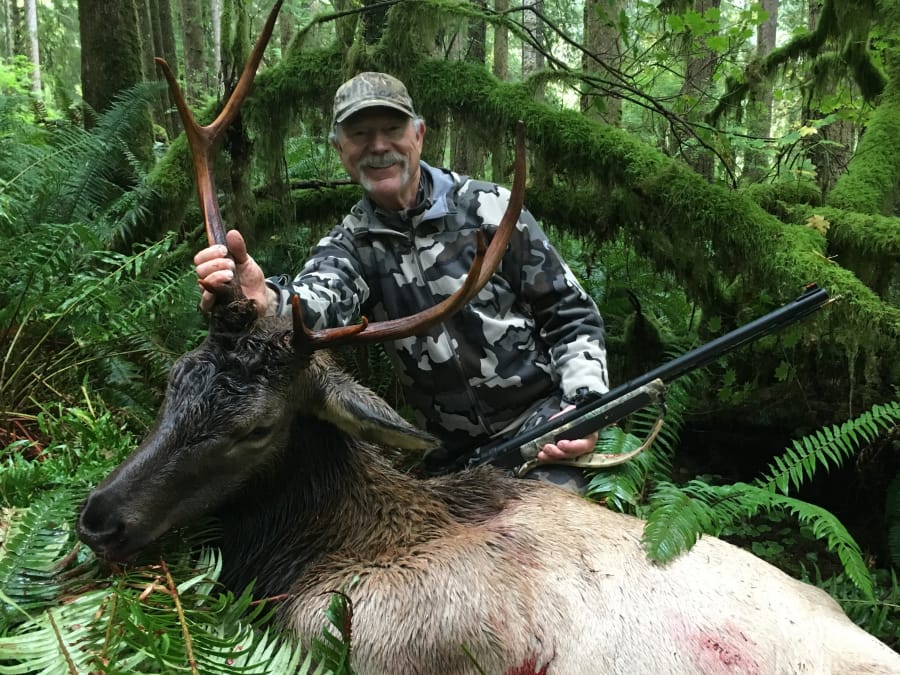What a difference a decade can make.
In 2008, the Mount St Helens elk herd was thriving, and the population was so high antlerless permits were being issued to reduce the herd. The same year hoof disease became prevalent enough to spark real concern.
Still, harvests in District 10 continued to be good through 2012, when more than 3,000 elk were harvested. Special permit hunts were a large percentage of the total, driven by the antlerless harvest.
Compare that with the harvest in 2017, when about 1,200 elk were taken, and there was very minimal harvest attributed to special permits.
Ten years of the spread of hoof disease and efforts to cull breeding cows had already reduced the herd before the devastating winter of 2016 hit. Heavy snow and cold, wet conditions took a toll on the animals, and an estimated 30 to 35 percent of the herd perished, according to the Washington Department of Fish and Wildlife District 10 Hunting Prospects.
“It’s sad to watch the elk numbers disappear,” said Mike Jenkins of Upfront Outfitters, who has spent decades guiding for elk and deer in Southwest Washington. “There are less animals out there, and they are getting harder to hunt. We used to get good bulls in every two or three days. Now it’s about every seven to ten days.”
District 10 prospects
Last year, a total of 981 elk were harvested during the general season in addition to 192 elk harvested by permit in District 10. The highest general season harvests in 2017 were in Game Management Units 520 (Winston), 506 (Willapa Hills), 530 (Ryderwood), and 550 (Coweeman).
The winter of 2017-18 was mild, and survey efforts conducted during spring 2018 showed an increase of approximately 5 percent. These indicators point toward an elk population that is recovering but still below objectives. Hunters will undoubtedly find less elk this year than usual, but numbers are improving.
Surveys of the elk populations in GMUs 506 (Willapa Hills) and 530 (Ryderwood) indicate a stable or slightly increasing elk population in GMU 506, while the population in GMU 530 seems to be declining slightly.
Hunter access remains an issue in Southwest Washington. Most tree farm properties that used to be free access now require a paid-for permit.
“The timber companies own a huge portion of Southwest Washington,” said Eric Holman, the wildlife biologist for District 10. “That was a big deal when they started that in 2014. I don’t see that changing anytime soon.”
Hunters without access permits will have to make due with patches of DNR lands and some BLM properties. There are national forest lands available, but they are deep and overgrown. Yes, there are elk in there, but they are tough to hunt.
Hoof disease update
Hoof disease continues to be prevalent in the Mount St. Helens elk herd, and the disease has now spread to the east side of the Cascades.
The disease causes severe hoof deformities which can eventually render the animals unable to walk and feed, or protect themselves against predation.
In August, veterinarian and elk hoof disease specialist Margaret Wild assumed the lead in the state’s efforts to battle the outbreak. She was hired by the Washington State University College of Veterinary Medicine, which was assigned the task of leading the research into the disease by the Washington state legislature.
Ten weeks into the effort she is getting her feet under her.
“It has been a busy two and a half months,” said Wild. “I’ve had the opportunity to talk to many of the stakeholders, who have been watching this disease for 10 years.”
Wild has designed a four-pronged approach to research and identify the pathogens involved, and learn how best to counter the disease.
Number 1: study the disease in the animals.
“We are currently designing the captive elk facility, and it should be up and running next year,” said Wild. The facility will allow the study of how the disease affects the animals over time in a controlled environment.
Number 2: study the disease agents in the lab.
“The Treponeme bacteria is one piece of the puzzle,” said Wild, “but there are other pieces we don’t understand.”
Researchers are currently looking at samples taken in the past, and validating the results as well as applying new techniques to identify disease-causing organisms. They will also be looking at other possible factors contributing to the disease.
Number 3: Study the disease across the landscape.
Wild said researchers want to know where the disease is present, not just in Washington, but in other states as well. They will be looking to establish baseline information so that changes, for good or bad, can be documented.
Number 4: Understand the social aspects of the disease.
“Input from the public is very important,” said Wild. “This will guide our outreach and education.”
While most hunters are knowledgeable concerning the disease, what about other wildlife observers? Hikers and others may see limping elk and not know what is happening. If Wild and the researchers know where the knowledge gaps are, they can tender their efforts toward filling those gaps.
Unfortunately, it will still take some time to gather enough information, so a solid, effective approach to slow or stop the spread of the disease can be found.
Every piece of information is a step forward to understanding of the disease but Washington hunters and wildlife lovers will have to remain patient, at least for the near term.
Leave hooves on site
It is unlawful to transport the hooves of harvested elk beyond the site where the animal was killed in Game Management Units 407, 418, 437, 454, 501 through 564, 568, 572, 574, 578, 633, 636, and 642 through 699.
Hunters can report infected animals or limping elk at the WDFW elk hoof disease web page. Always check the regulations before hunting.




